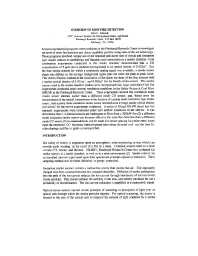Mining Publication: Overview of Mine Fire Detection
Original creation date: August 1998
Several experimental programs were conducted at the Pittsburgh Research Center to investigate the level of mine fire detection and alarm capability possible using state-of-the-art technology. These programs involved comparison of the response and alarm time of optical and ionization type smoke sensors to smoldering and flaming coal combustion in a smoke chamber. Coal combustion experiments conducted in the smoke chamber demonstrated that a CO concentration of 5 ppm above ambient corresponded to an optical density of 0.022m-1. For the four smoke sensors for which a continuous analog signal was available, a smoke sensor alarm was defined as the average background signal plus ten times the peak-to-peak noise. This alarm criterion resulted in the association of the alarm for three of the four sensors with a smoke optical density of in the smoke chamber studies were incorporated into large scale diesel fuel fire experiments conducted under normal ventilation conditions in the Safety Research Coal Mine (SRCM) at the Pittsburgh Research Center. These experiments showed that a diffusion mode smoke sensor alarmed earlier than a diffusion mode CO sensor; and, based upon the measurement of the optical transmission at the location of a pump mode ionization smoke sensor alarmed at an average smoke optical density of 0.021m-1 for the twelve experiments conducted under zero airflow conditions in the SRCM. It was determined that: (1) thermal sensors are inadequate at 30m from a 300kW fire; (2) a diffusion mode ionization smoke sensor can be more effective for mine fire detection than a diffusion mode CO sensor; (3) recommendations can be made for sensor spacing in a mine entry based upon the measured CO buoyancy induced spread rates along the mine roof and the time for a developing coal fire to ignite a conveyor belt.
Authors: JC Edwards
Conference Paper - August 1998
NIOSHTIC2 Number: 20000100
Proc Second International Conference on Fire Research and Engineering (August 3-8, 1997; Bethesda, MD), 1998 Aug :489-499
See Also
- A Comparison of Mine Fire Sensors
- Fire Detection for Conveyor Belt Entries
- In Mine Evaluation of Discriminating Mine Fire Sensors
- In-Mine Evaluation of Smart Mine Fire Sensor
- In-Mine Evaluation of Underground Fire and Smoke Detectors
- Mine Fire Detection in the Presence of Diesel Emissions
- Mine Fire Detection in the Presence of Diesel Emissions
- Mine Fire Source Discrimination Using Fire Sensors and Neural Network Analysis
- Rapid Detection and Suppression of Mining Equipment Cab Fires
- The Use of Light Scattering and Ion Chamber Responses for the Detection of Fires in Diesel Contaminated Atmospheres
- Page last reviewed: 9/21/2012
- Page last updated: 9/21/2012
- Content source: National Institute for Occupational Safety and Health, Mining Program


 ShareCompartir
ShareCompartir
